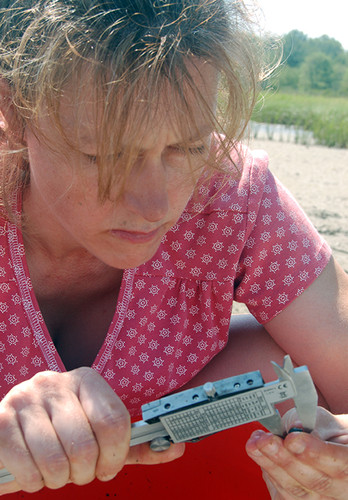The Wrack
The Wrack is the Wells Reserve blog, our collective logbook on the web.
The Wrack is the Wells Reserve blog, our collective logbook on the web.
When green crabs arrived in New England more than 150 years ago, they found an unoccupied ecological niche in Maine’s salt marshes. Despite their long occupancy, great abundance, and serious impacts, there is a lot left to learn about green crabs. The reserve’s latest research has focused on understanding seasonal movements, population structure, sexual maturity, and effects on habitats.
 The invasive European green crab is not only a popular topic in the media these days; here at the reserve green crabs are receiving their fair share of attention as well — 5,878 of them so far to be exact!
The invasive European green crab is not only a popular topic in the media these days; here at the reserve green crabs are receiving their fair share of attention as well — 5,878 of them so far to be exact!
The Wells Reserve has teamed up with the University of Maine, Casco Bay Estuary Partnership, and Southern Maine Health Care to study the impacts of the invasive European green crab (Carcinus maenas) on the geology and “stability” of our marshes. Over the summer we have been collecting abundance data that will later be used in conjunction with fyke net data, water quality data, and even geological techniques to better understand the effects green crabs are having on salt marshes throughout southern Maine.
Create a U.S./Canada working group, identify research gaps, and establish a regional approach to blue carbon science and policy.
 Jennifer Dijkstra was always going to be a scientist. As a child summering on Grand Manan, she clambered over the island’s rocky shoreline grabbing fistfuls of seaweed and peering into shallow waters to spy on crabs and snails. This summer she’s been doing the same thing, but with three degrees of separation (BS, MS, and PhD), she now calls her objects of interest Ascophyllum, Carcinus, and Littorina.
Jennifer Dijkstra was always going to be a scientist. As a child summering on Grand Manan, she clambered over the island’s rocky shoreline grabbing fistfuls of seaweed and peering into shallow waters to spy on crabs and snails. This summer she’s been doing the same thing, but with three degrees of separation (BS, MS, and PhD), she now calls her objects of interest Ascophyllum, Carcinus, and Littorina.
For many budding biologists, the journey from tide pool playground to salt marsh research transect stops short. For Dr. Dijkstra, research scientist at the Wells Reserve, the dream came true.
It is probably a rare coastal beachfront property owner who is not aware that beaches are dynamic systems that erode and accrete in response to storms, sediment supply, rising sea level, and the proximity of sea walls, jetties, and other forms of coastal "armor." Many beachfront owners are also aware that "natural" barrier beaches and their dune systems are able to persist in the face of sea level rise by transgressing, or migrating shoreward.